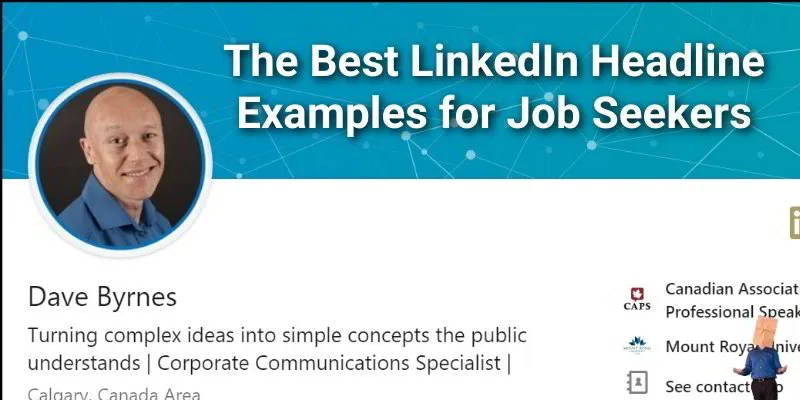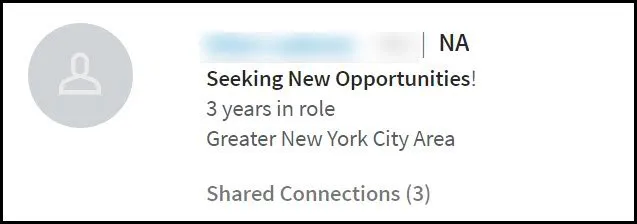Writing a LinkedIn headline for job seekers is a difficult task that confuses many people in their job search.
The best LinkedIn headline examples for job seekers show employers the job you want next, not your last role or that you are unemployed. A professional LinkedIn profile should convey your value and experience. No employer is searching for “seeking new opportunities”, they want the best candidate.
Many people waste the opportunity by looking like every over job seeker and failing to communicate their value to an employer. LinkedIn headlines are the largest wasted opportunity in a LinkedIn job search and can even hurt many job seekers’ prospects.
The Best LinkedIn Headline Examples for Job Seekers
Let's take a look at some examples of headlines that go past just a job title and convey the value a job seeker can bring to an organization.
Communications: “Producing clear, simple messages the public understands | Corporate Communications Specialist”
Accounting: “Turning raw data into patterns leadership can act on | Corporate Accountant | Production Accounting”
Marketing: “Matching marketing strategies to client vision to deliver results | Marketing Director | Marketing Strategist
Banking: “I solve problems and give away money | Commercial Loans Administrator | Documentation |
The Worst LinkedIn Headline Examples for Job Seekers
A poor headline on LinkedIn typically gives the reader no more information than a job title and asks them to do all the work to find out if you are who they are looking for. Many employers and recruiters will not take the time to.
Here are some examples of LinkedIn headlines that only give away the barest of information:
"Manager at ABC Corp."
"Accountant at XYZ Accounting."
Examples like these either don't give information about their industry or department, or they fail to signal what level of experience the job seeker is at. Again, it asks the employer or recruiter to do all the work.
The worst LinkedIn headlines for jobs seekers do two things:
- They repeat the above mistake of providing no information about their industry or level of experience.
- The label themselves as unemployed or seeking opportunities
"Unemployed at Seeking New Opportunities."
"Seeking Next Adventure at Unemployed."
No employer is typing "unemployed" into a LinkedIn's search engine. They are looking for production accountants, communications advisors, senior sales managers, etc.
While there is no shame in being unemployed, it is not a selling point. You need to lead with information that tells an employer they are looking at someone with the right experience or they are moving on to the next person.
How to Write a Professional LinkedIn Headline
To produce the best LinkedIn headline possible, you have to understand what you are trying to achieve:
- First of all, you need to be found. To do this you will need the job title and industry keywords in your headline.
- Second, you need a way to stand out from the crowd. You need a short, sharp description of what value you bring to an employer.
If your headline doesn’t communicate to an employer or recruiter that you are a valuable candidate, it’s over, they have moved on to the next profile.
We will dive deeper into how to do this below. What we also need to consider is the constraints and opportunities between an unemployed job seeker and an employed one.
How to Write a LinkedIn Headline When Unemployed
One advantage you have as an unemployed job seeker is you can shout from the hilltops that you are looking for work. Clearly, you don’t have to worry about tipping off your boss.
There is, however, a difference between announcing you are ready for a new role and declaring to potential employers you are unemployed.
I don’t believe there is a benefit in announcing you are unemployed in your headline because no company is searching for “unemployed” in a LinkedIn search. Employers are looking for the best candidate for what you do.
You can differentiate yourself from employed job seekers by including the next job you want as part of your headline. Someone employed has to be more cautious.
For example, if your experience qualifies you to move from a “communications advisor” to a “communications specialist” there is nothing stopping you from putting specialist in your headline.
In the headline, your only goals are to be found and clicked on. You can explain in your LinkedIn Summary that you are currently looking for work and want to advance from your last role.
When deciding on whether to put your previous title or your desired title, it will pay huge dividends to talk directly with hiring managers and recruiters and ask what title they are using in searches for candidates.
If you are looking for the same role as you last had, you can stick with that job title.
How to Write a LinkedIn Headline When Employed
As an employed job seeker on LinkedIn, you can’t be too obvious that you are looking for a new job.
Luckily, the best advertisement for the next role is being awesome at what you do now.
One of the annoying facts of job search is that it is easier to get a job when you already have one. Part of the reason for this is employers want the best in the industry and the impression is that these people are currently employed.
There are two ways to approach appearing in searches by employers when you are currently employed:
- The first method is to simply state your current position in your headline. If employers or recruiters are looking for a “communications advisor” ready to take the next step in their career, then you will be easy to find.
- The second method is to use a title that is a little more generic but would appear in searches (without letting your boss know you are shopping around). “Communications expert” or “Corporate Communications Professional” are examples of having enough keywords without pigeonholing you.
You are more than your job title. There is no law that you have to state it in your LinkedIn headline.
Again, the only way to know what keywords will get your found is to talk to employers and recruiters in your industry about what they look for.
What to Put in Your LinkedIn Headline
Once you have the right keywords to be found, it is time to differentiate yourself from the crowd. You have about 120 characters available in a professional LinkedIn headline so there’s no reason to stop after adding job title keywords.
Ask yourself:
- What is your value proposition?
- What do you do better than others in your role?
- How do you make a difference for an organization?
This is where a lot of people struggle because we all find it hard to shine the spotlight on ourselves and say what we are best at.
Let’s take the focus off you for a second. Think about your potential hiring manager; the boss you would work directly under. What are her problems?
In the case of a communications manager, it may be getting the company’s key messages out and understood by the public. As a potential communications specialist, my value proposition would be: “Producing clear, simple messages the public understands.”
For this headline example, I am solving the hiring manager’s problem with my value proposition. This makes me stand out from every other candidate whose professional headline simply reads “communications specialist.”
What does a headline do on LinkedIn?
A professional LinkedIn headline (plus your photo) is the only thing a potential employer or recruiter will see when deciding whether to view your LinkedIn profile.
Your LinkedIn headline is not the same as your current job title. They are separate sections within your LinkedIn profile and do different things.
You will find your headline just under your profile picture at the top of your summary. Your Job Titles are linked to each work experience you enter into your profile further down.
Your headline on LinkedIn is also a vital search engine area, meaning that if you don’t have the right keywords in your headline, you may not be found in searches by recruiters and employers. When your profile appears in a LinkedIn search or a suggestion (like the People also viewed section) all a potential employer sees is your headline and picture.
When you don’t have a headline (leave it blank) LinkedIn can penalize you by not including you in searches, even ones for your name. If you can’t be bothered providing a headline on your LinkedIn profile why would an employer bother using their valuable time by clicking on your profile?




